You are probably here because you want to know if you can delete pagefile.sys right ;D
Gotcha! :)
The topic of running without a pagefile is a popular one.
Unfortunately most of the discussion is usually based around anecdotal evidence.
This article aims to provide you with the information you need to find out if you need a pagefile and provides benchmarks on my results of running with and without a pagefile.
*Warning – This is a long article with lots of information. You may want to bookmark it for later. My Anecdotal Evidence
I have been running Windows 7 without a pagefile for 11 months now on my main computer.Unfortunately most of the discussion is usually based around anecdotal evidence.
This article aims to provide you with the information you need to find out if you need a pagefile and provides benchmarks on my results of running with and without a pagefile.
*Warning – This is a long article with lots of information. You may want to bookmark it for later. My Anecdotal Evidence
It has been part of my testing and research into Windows 7′s memory management.
I have not had a single issue in running without a pagefile
Main Computer Specs
OS – Windows 7 Home Premium x64 dual-boot with openSUSE 11.4
Motherboard – Gigabyte GA-EP35C-DS3R
Processor – Intel Core 2 Quad Q9450 (Yorkfield), 2666 MHz
Memory – 8 GB, G.Skill F2-8500CL5-2GBPK, 4096 MB (DDR2-800 DDR2 SDRAM)
Video – Radeon HD 5750
Sound – onboard Realtek
Network – Realtek Gigabit
Hard Drives:
Intel X25-M Solid State Drive, 80GB SATA II (G2)
WD VelociRaptor WD3000HLFS WD
WD Caviar Black WD1001FALS
Why I Started This Experiment
1 – I had 8GB of RAM.
2 – I only gave my Windows 7 partition 30GB of space on the SSD so space is an issue.
3 – There are arguments and opinions all over the web on this issue.
4 – To see what would happen.
Just because I am able to run error free without a pagefile doesn’t mean that it is an optimal solution. I had been meaning to benchmark the performance of not having a pagefile and it is high time I got around to it.
*** This article only applies to Windows 7 ***
Important Notes Before We Begin
*I have overly simplified the discussion here to make it easier for the non-Geek to understand.
So, please cut me some slack here Geeks!
Is it called the: Pagefile, Page File, Paging File, or Swap File?
Short answer: Any / All of the above.
In Windows the file is called pagefile.sys. Microsoft documentation usually uses “pagefile” “paging file” and “page file”.
That documentation also usually calls the actual act “paging”.
Linux uses the term “swap file”.
In reality any of those terms is fine, folks will know what you mean. Only the lonely, basement-dwelling nerd really cares.
What is the Pagefile and what does it do?
The pagefile is a sort of backup for data put in physical memory (RAM).
It is put into one file called pagefile.sys.
When you start Windows or launch a program that programs important files are put into RAM because RAM is faster than a hard drive. “When the memory in use (that is, has been reference) by all the existing processes exceeds the amount of RAM available, the operating system will move pages (4 KB pieces) of one or more virtual address spaces to the computer’s hard disk, thus freeing some RAM for other uses. In Windows systems, these “paged out” pages are stored in one or more files with the name pagefile.sys.” (source)
In actuality the pagefile and it’s inner workings in Windows 7 is more complicated than this. You’ll need to read the Important Links on this page to really understand it.
Do you need a page file?
Maybe yes, maybe no. No, it isn’t a cop out answer. The only way to find out is to test it.
And yes, that means you actually have to do some work and take responsibility for your actions.
Pagefile size: 1x, 1.5x, 2x, 3x?
In the last few years Mr. Russinovich began belittling the advice of using some factor (1x, 1.5x, 2x, 3x) of RAM to determine the best pagefile size. I call it the “some X RAM factor”. Others soon began parroting this sentiment.
The reason the “some X RAM factor” exists in the first place is because for years that has been Microsoft’s advice (you know, the company he works for).
Even in Windows 7 the calculation for the pagefile size is based on “some X RAM factor”.
Another is, based on the above, exactly how are you going to explain the whole pagefile size thing to a novice without using “some X RAM factor”?
This isn’t meant to pick on Mr. Russinovich. Clearly the man knows more about Windows internals than I ever will. But like I said, the whole reason the “some X RAM factor” thing exists is because of Microsoft. I should note that during the research of this article it is obvious that Microsoft is trying to undo that mistake. Newer articles on Virtual Memory and revised older articles are doing away with the “some X RAM factor” advice.
How can I test it if I don’t understand what is discussed in these pages?
I told you you would have to do some work. That includes studying!
Do I really need to go through all this studying and testing?
No, The pagefile and your computer will run just fine at its default setting.
So why test it at all?
It’s a Geek thing, you wouldn’t understand.
Seriously though, paging and the page file do 3 things.
1 – Use disk space.
2 – Cause disk activity (reading/writing, but mostly reading).
3 – Use CPU cycles.
Optimizing and/or eliminating the page file can reduce these.
What can happen if I screw it up? or What can happen during testing?
Low memory errors resulting in a pop-up screen (if you’re lucky), Program / event log errors, blue screens, disk corruption. Possible data loss as a result.
- Bluescreens (possibly resulting in data loss / corruption) Windows usually isn’t the culprit here. Most of the time it is a driver or program leaking memory (*cough* firefox *cough*). In the past I’ve seen some Windows gadgets leak memory.
- I have read of people complaining of problems coming out of Sleep mode without a page file. I’ve been unable to reproduce this issue.
The point is, backup your computer before testing.
Crash Dumps! Oh My!
Yeah, any article or forum thread on the pagefile issue some Geek-wanna-be will spout of with something like, “if you don’t have a page file Windows can’t create a crash dump file”.
First off most folks wouldn’t know where to find that info and what to do with it if they did find it.
Secondly, if that is a concern for you then there is a workaround right here.
Even Microsoft’s Mark Russinovich notes the crash dump issue as a cause of concern.
However you should note that Mr.Russinovich’s audience is admins and coders, not the average user.
You have said before that Windows needs a pagefile. What changed?
Windows and Hardware changed.
All versions of Windows are designed to use a pagefile. Some apps are/were too. Memory management has drastically improved with Vista and more so with 7.
Hardware has gotten faster than I imagined it would at this point. Truthfully most folks use a fraction of the power in modern hardware. Then we get to RAM. I don’t think anyone ever envisioned that home users would have 4+ gigs of RAM and that RAM would be so inexpensive. I mean my phone has as much CPU power and RAM as my computers had not too long ago!
I have always tried to write give safe, solid advice. But that advice must change as the circumstances warrant.
I still think the average user should leave the pagefile alone.
In this case the average user is someone who will not take the: 1 – Time to understand it, 2 – Time to test it, and 3 – Responsibility for their actions.
Who is this Mark Russinovich you keep mentioning?
Geek, Software Author (co-author at Winternals / Sysinternals), Book Author, now a big-wig at Microsoft. Mark Russinovich at Wikipedia TechNet Blogs > Mark’s Blog TechNet Blogs > Mark’s Blog > About Mark’s Blog
Important Links and Notes
The links below are ones you need to read and understand when discussing the Windows pagefile. Pushing the Limits of Windows: Virtual Memory ( Mark Russinovich ) This is a must read! PerfGuide: Out of System Committed Memory ( Microsoft ) Understanding Virtual Memory ( Perris Calderon ) RAM, Virtual Memory, PageFile and all that stuff ( Bruce Sanderson ) Learn Best Practices for Optimizing the Virtual Memory Configuration ( Ed Bott, Carl Siechert, and Craig Stinson ) Preventing low memory problems ( Microsoft )
Slides from Mark Russinovich at PDC 2010
(see this page for links to downloads and videos) CD1 – Slide 26
Sizing the Paging File
If you enough RAM to support your commit needs, why even have one?
-System can page out unused, modified private pages vs keeping them in RAM
-More RAM available for useful stuff
Many recommendations use a formula based on RAM (1.5x, 2x, etc.)
-Actually, the more RAM, the smaller the paging file needed
-Should be based on workload usage of committed virtual memory
Look at commit peak after workload has run
-Pre-Vista: Task Manager
-Vista+: Process Explorer
-Apply a formula to that to give buffer (1.5x or 2x)
-Make sure it’s big enough to hold a kernel crash dump
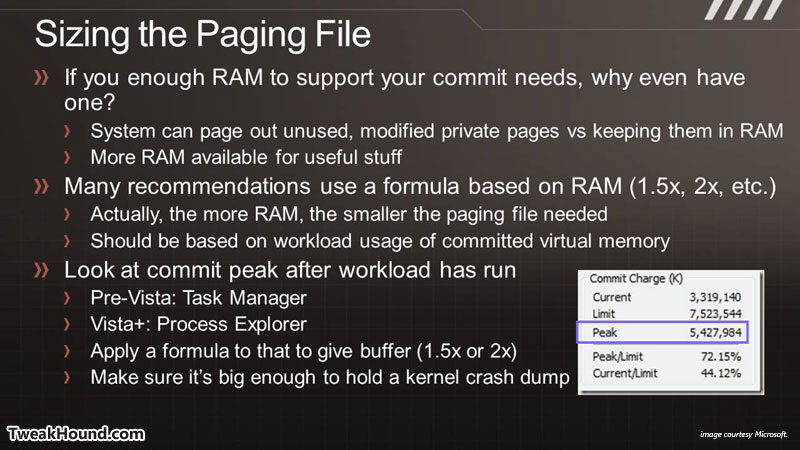
CD1 – Slide 21
The System Commit Limit
System committed virtual memory must be backed either by physical memory or stored in the paging file
-Sum of (most of) physical memory and current paging files
Allocations charged against the system commit limit:
-Process private bytes
-Pagefile-backed shared memory
-Copy-on-write pages
-Read/write file pages
-System paged and nonpaged code and data
When limit is reached, virtual memory allocations fail
-Processes may crash (or corrupt data)
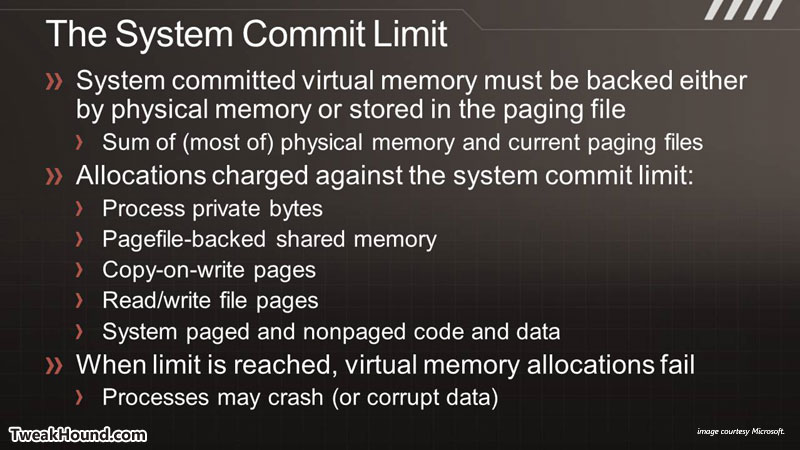
Testing With And Without A Pagefile
Something you need to understand before we continue are the terms Commit Limit and Commit Peak.Commit Limit
In Windows 7 the Commit Limit is the sum of RAM + Page File (roughly).
If you have 4GB of RAM and a 4GB pagefile then you have an 8GB Commit Limit (roughly).
This is the maximum amount of memory available to the operating system. Quote from Microsoft:
The Commit Limit
The Commit Limit of Windows is the total amount of RAM and the size of all of the page files combined on the system. It is the maximum amount of system committed memory that the system can handle unless RAM is “hot-added” or the page file is increased.
The Commit Charge or Committed Bytes is the total amount of memory used/committed by the operating system and all processes running on the computer. This memory is “in use” and has been written to by a process or by the kernel.
Commit Peak
If you view the current Commit Charge this is how much virtual memory your system is actually using.
That is the sum of RAM + Pagefile actually used.
If you measure the total used over a period of time you can call this the Commit Peak.
Mr.Russinovich refers to this as Peak Commit Charge.
How to find your Commit Peak
1 – Download Process Explorer. Extract the file.
2 – Load every program you would normally have open at one time and actually use them a bit.
3 – Run Process Explorer and go to:
View > System Information >
in the resulting window click the Memory tab >
then see the line Peak/Limit. This is your Commit Peak.
*Note – Windows actually tracks this you just cannot see it in Task Manager. Running Process Explorer after this test but before reboot is fine.
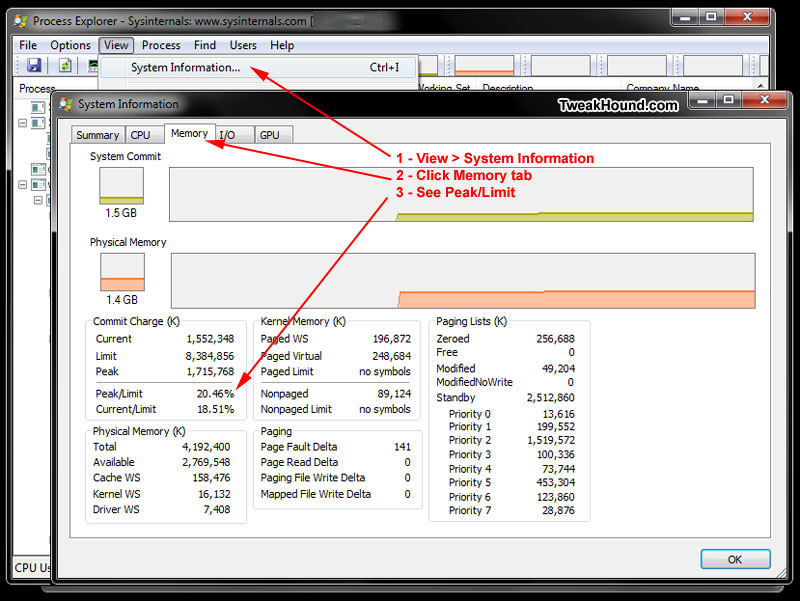
How To Size Your Page File After Finding Your Commit Peak
I will let Mr. Russinovich tell you:
- So how do you know how much commit charge your workloads require? You might have noticed in the screenshots that Windows tracks that number and Process Explorer shows it: Peak Commit Charge. To optimally size your paging file you should start all the applications you run at the same time, load typical data sets, and then note the commit charge peak (or look at this value after a period of time where you know maximum load was attained). Set the paging file minimum to be that value minus the amount of RAM in your system (if the value is negative, pick a minimum size to permit the kind of crash dump you are configured for). If you want to have some breathing room for potentially large commit demands, set the maximum to double that number.
Running Without A Pagefile. The Benchmarks
I am not one of those people who believe benchmarks are a way to evaluate the difference between computers or operating systems.
I do believe they are a good way to evaluate your computer against itself. i.e. to measure the effects of changes to your system.
Benchmarks Used
1 – Boot and Shutdown times. Taken from Event Viewer > Applications and Services Logs > Microsoft > Windows > Diagnostics-Performance > Operational
2 – Running a lot of apps (to observe Commit Peak as describe in the previous How to find your Commit Peak section of this article).
3 – PCMark 07 Basic v104
4 – SiSoft Sandra 2011 Pro Home SP4c
5 – PassMark Performance Test
6 – Crysis (Assault Harbor)
7 – SYSmark 2012
Computer Specs
OS Name Microsoft Windows 7 Home Premium
Version 6.1.7601 Service Pack 1 Build 7601
System Manufacturer Dell Inc.
System Model Inspiron 530
System Type x64-based PC
Processor Intel(R) Core(TM)2 Quad CPU Q6600 @ 2.40GHz, 2400 Mhz, 4 Core(s), 4 Logical Processor(s)
Installed Physical Memory (RAM) 4.00 GB DDR2(PC2-6400)
Video ATI Radeon HD 5670
Sound SoundBlaster XFI Fatality
Drives:
OS drive – 2 x WD Raptor 150′s in RAID 0 (modded BIOS for RAID 0)
Other drive – Seagate Barracuda ST31000333AS 1-TB
I choose my older computer because:
1 – It more closely represents what the average reader / user will have vs. my main rig.
2 – My main rig has had the hell beat out of it benchmarking over the last 3+ years and I just didn’t want to pound on it any more.
About my testing.
I can only test so many scenarios. I don’t know what programs you use on your computer, what kind of hardware you use, how often you reboot,if/how/what you tweaked, what power options you are using, etc.
The point is I can only tell you what I’ve seen. For results that apply to your computer you have to test it yourself.
In real world use I don’t leave my computer on if I’m away from it for more than 30 minutes, I don’t use sleep, hybrid-sleep, or any power saving options. Obviously my computers are tweaked out and well maintained.
Also, I am not an avid gamer. Although I used to play computer games a lot, most modern games bore the hell out of me. Been there, done that. Some modern games use a lot of memory and I’ve not tested them. If you have any experience with the modern memory intensive games and no pagefile please let me know your findings.
Here is how I benchmark in general:
1 – I only do my computers as they are configured for day-to-day use. In other words, exactly as I use them. No test machines, no clean installs, no special tweaks or optimizations.
2 – I image the computer to the most recent backup, install all updates and most recent drivers.
3 – Install and run the benchmark program once (if not already installed).
4 – Check the error logs and try to resolve any issues.
5 – Clean computer(ccleaner/bleachbit). Defrag (perfectdisk).
6 – Try for 3 runs of any benchmark or measurement. Again checking the error logs along the way for any anomalies.
For this round of benchmarks (in addition to steps 1-5 above):
1 – Startup (cold start) and let computer stand for 10 minutes.
2 – Started without pagefile. 3 successive runs* of the benchmark without rebooting.
3 – Clean computer(ccleaner/bleachbit). Enable pagefile (equals RAM, static 4096MB/4096MB). Shut down.
4 – Startup (cold start) and let computer stand for 10 minutes.
5 – 3 successive runs* of the benchmark without rebooting.
6 – Check error logs.
*Why successive runs? Because of what I am attempting to measure. I am not trying to benchmark hardware or a specific app/game.
—–
Boot Time
Without Pagefile
29913ms
30976ms
29448ms
Average = 30112.33
With Pagefile = RAM (4096MB)
30388ms
31659ms
31279ms
Average = 31108.66
Difference: 31108.66 – 30112.33 = 996.33ms (or 0.99633 seconds)
Result: 996.33 makes the boot time without pagefile 3.202741616000175 percent faster than with pagefile.
Conclusion: Boot time is marginally improved without a pagefile.
Shutdown
Without Pagefile
4708ms
4414ms
4656ms
Average = 4592.66
With Pagefile = RAM (4096MB)
4927ms
4922ms
5065ms
Average = 4971.33
Difference: 4971.33 – 4571.33 = 378.67ms (or 0.37867 seconds)
Result: 378.67ms makes shutdown 7.617076315593614 percent faster without a pagefile.
Conclusion: Shutdown time is slightly improved without a pagefile.
Boot and Shutdown time overall conclusion
Both times improved without a pagefile. However, in the case of this system there is a less than 1 second improvement for each.
I should note that changes to my main system produced similar results.
Based on this, it is my opinion making changes to the pagefile for the sake of these marginal (at best) improvements would be ridiculous.
—–
Running Lots Of Applications
Not a benchmark per se but more for information purposes.
4GB of RAM with no pagefile running:
Photoshop 7 with 6 files totaling 86.9MB
Media Monkey playing mp3
iTunes playing mp3
Windows Media player playing video
TeamViewer with active connection
Microsoft Word (2 docs)
Adobe Reader 10 (1 pdf)
IE9
Firefox
Explorer (2 windows plus 1 file copy in progress)
Process Explorer
Result: 48.99% Commit Peak
Click on the picture below for a full size image of the result.
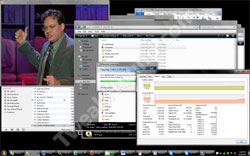
—–

PCMark 7
Without Pagefile
1 – 2417
2 – 2441
3 – 2419
Average = 2425.66
With Pagefile
1 – 2413
2 – 2418
3 – 2420
Average = 2417
Difference: 2425.66 – 2417 = 8.66
8.66 is a 0.3582954075299959 percent improvement over 2417.
Result: Difference is statisically insignificant.
Conclusion: With 4GB of RAM, for PCMark 7 there is no difference between having a pagefile and not.
—–

SiSoft Sandra 2011 Pro Home (SP4c) Overall Score
New Benchmark: Overall Score for computer performance evaluation (SP3)
Why? While each benchmark measures the performance of a specific device (CPU, Memory, GPU, Storage, Network), there was a need for a benchmark to evaluate the overall computer performance: this new benchmark is a weighted average of the individual scores of the existing benchmarks:
-(Native) CPU Arithmetic/Multi-Media: measures native CPU performance
-.Net/Java Arithmetic/Multi-Media: measures software virtual machine performance (e.g. for .Net/WPF applications)
-Memory Bandwidth: measures memory performance
-Physical Disks: measures storage performance
-Video Shading/Bandwidth: measures GPU performance
With Pagefile
1 – 5.11kPTS
2 – 5.12kPTS
3 – 5.19kPTS
Average = 5.14
Without Pagefile
1 – 5.13kPTS
2 – 5.16kPTS
3 – 5.17kPTS
Average = 5.1533
Difference: 5.1533 – 5.14 = 0.0133
0.0133 is a 0.25875486381322954 percent improvement over 5.14.
Result: Difference is statisically insignificant.
Conclusion: With 4GB of RAM, for Sandra there is no difference between having a pagefile and not.
—–

PassMark PerformanceTest – All Tests
With Pagefile = RAM
1- 1359.0
2- 1403.6
3- 1460.1
Average = 1407.566
Without Pagefile
1- 1361.4
2- 1455.0
3- 1457.4
Average = 1424.6
Difference 1424.6 – 1407.566 = 17.034
17.034 is a 1.2101741587961061 percent improvement over 14.07.566.
Result: Although not having a pagefile had a better average score the highest score was with a pagefile.
Conclusion: With 4GB of RAM, for PassMark PerformanceTest – All Tests there is slight advantage in not having a pagefile (see note).
—–

Crysis Assault Harbor
The output displayed below is the exact output from the benchmark.
No Pagefile
— Crysis Benchmark, No Pagefile —
9/6/2011 10:36:18 AM – Vista 64
Beginning Run #1 on Map-harbor, Demo-Assault_Harbor
DX10 1680×1050, AA=No AA, Vsync=Disabled, 64 bit test, FullScreen
Demo Loops=3, Time Of Day= 5
Global Game Quality: VeryHigh
==============================================================
TimeDemo Play Started , (Total Frames: 4100, Recorded Time: 132.23s)
!TimeDemo Run 0 Finished.
Play Time: 269.52s, Average FPS: 15.21
Min FPS: 9.30 at frame 803, Max FPS: 19.86 at frame 955
Average Tri/Sec: -4216048, Tri/Frame: -277148
Recorded/Played Tris ratio: -0.05
!TimeDemo Run 1 Finished.
Play Time: 255.27s, Average FPS: 16.06
Min FPS: 9.30 at frame 803, Max FPS: 19.86 at frame 955
Average Tri/Sec: -5106907, Tri/Frame: -317964
Recorded/Played Tris ratio: -0.04
!TimeDemo Run 2 Finished.
Play Time: 253.70s, Average FPS: 16.16
Min FPS: 9.30 at frame 803, Max FPS: 19.86 at frame 955
Average Tri/Sec: -5142873, Tri/Frame: -318227
Recorded/Played Tris ratio: -0.04
TimeDemo Play Ended, (3 Runs Performed)
==============================================================
Completed All Tests
<><><><><><><><><><><><><>>–SUMMARY–<<><><><><><><><><><><><><>
9/6/2011 10:36:18 AM – Vista 64
Run #1- DX10 1680×1050 AA=No AA, 64 bit test, Quality: VeryHigh ~~ Overall Average FPS: 16.11
With Pagefile
— Crysis Benchmark, 4GB Pagefile (equals RAM) —
9/6/2011 10:05:05 AM – Vista 64
Beginning Run #1 on Map-harbor, Demo-Assault_Harbor
DX10 1680×1050, AA=No AA, Vsync=Disabled, 64 bit test, FullScreen
Demo Loops=3, Time Of Day= 5
Global Game Quality: VeryHigh
==============================================================
TimeDemo Play Started , (Total Frames: 4100, Recorded Time: 132.23s)
!TimeDemo Run 0 Finished.
Play Time: 268.81s, Average FPS: 15.25
Min FPS: 6.54 at frame 805, Max FPS: 19.28 at frame 1351
Average Tri/Sec: -4334575, Tri/Frame: -284191
Recorded/Played Tris ratio: -0.05
!TimeDemo Run 1 Finished.
Play Time: 255.49s, Average FPS: 16.05
Min FPS: 6.54 at frame 805, Max FPS: 19.76 at frame 1717
Average Tri/Sec: -4972347, Tri/Frame: -309844
Recorded/Played Tris ratio: -0.04
!TimeDemo Run 2 Finished.
Play Time: 255.42s, Average FPS: 16.05
Min FPS: 6.54 at frame 805, Max FPS: 19.76 at frame 1717
Average Tri/Sec: -5030475, Tri/Frame: -313381
Recorded/Played Tris ratio: -0.04
TimeDemo Play Ended, (3 Runs Performed)
==============================================================
Completed All Tests
<><><><><><><><><><><><><>>–SUMMARY–<<><><><><><><><><><><><><>
9/6/2011 10:05:05 AM – Vista 64
Run #1- DX10 1680×1050 AA=No AA, 64 bit test, Quality: VeryHigh ~~ Overall Average FPS: 16.05
===============================================================
Difference: 16.11 – 16.05 = .06
.06 is a 0.37383 percent improvement over 16.05.
Result: Average and high score was slightly higher without a pagefile (as was the low score).
A closer look reveals significantly higher minimums without a pagefile ( 9.30 to 6.54).
Conclusion: Crysis performance may be improved without a pagefile. (Important – see next section)
Crysis Benchmark Commit Peak
Crysis uses a lot of memory.
In the test system with 4GB of RAM and no pagefile it used 87.57% of available RAM.
Based on this I would highly recommend at least 6GB of RAM to run Crysis without a pagefile.
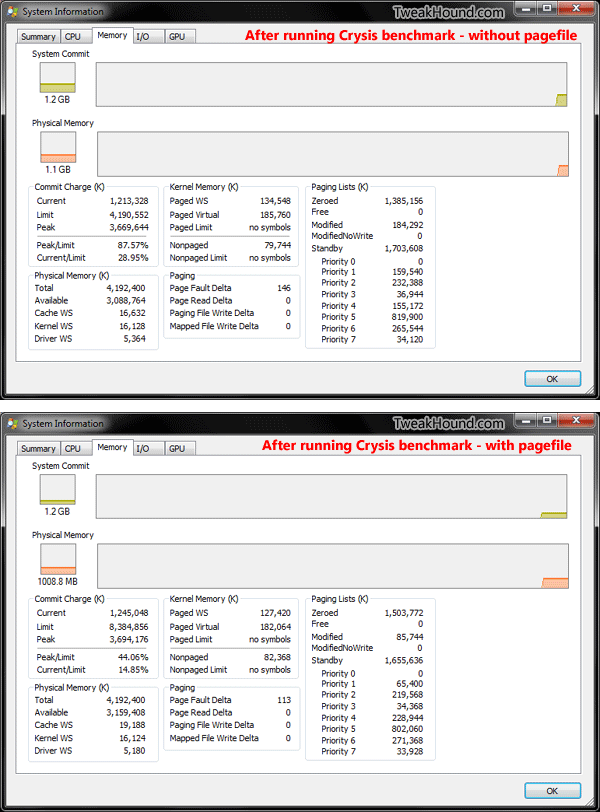
—–

SYSmark 2012
I would like to thank Bapco for providing Sysmark 2012. Of all the benchmarks in this article this is the one I was I really wanted to run.
It is really brutal on a system and each run took between 3.5 and 4 hours to run.
Sysmark 2012 benchmarks the following apps:
ABBYY FineReader pro 10.0
Adobe Acrobat Pro 9
Adobe After Effects CS5
Adobe Dreamweaver CS5
Adobe Photoshop CS5 Extended
Adobe Premiere Pro CS5
Adobe Flash player 10.1
AutoDesk 3DS Max 2011
AutoDesk AutoCAD 2011
Google Sketchup Pro 8
Microsoft Internet Explorer 8
Microsoft Office 2010
Mozilla Firefox Installer
Mozilla Firefox 3.6.8
Winzip Pro 14.5
Preparation
Unlike the other benchmarks it was necessary to do a clean install to run Sysmark. Windows 7 was installed with the latest drivers and fully updated. Next Sysmark was installed and a first run was performed. Then I defragged. Then an attempt was made to run Sysmark without a pagefile. There was a continuous freeze with Adobe CS5 . This was not unexpected as I have seen numerous statements around the web saying CS5 will not run without a pagefile.
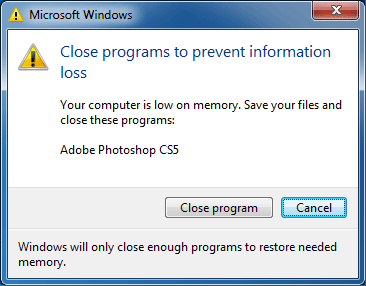
First off I checked the error logs and found a problem with the AMD Catalyst Control Center. I uninstalled that and installed the driver only. Next I was able to tweak the settings in CS5. I moved the scratch disk to another drive and lowered the memory settings to 1GB. These fixes allowed me to continue error free without a pagefile (so much for the “CS5 won’t run without a pagefile” crowd). After 2 runs I ran defrag again. Now I was finally set to run the actual benchmarks.
Results
Scores across all runs were virtually the same.
Final scores were identical.
You can view the full report by clicking on the picture below.
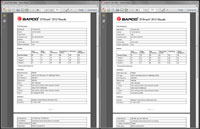
Conclusion
After 20 or so hours of prep and roughly 32 hours of benchmarking there was no difference between having a pagefile and not.
—–
Article Conclusion
The statements below are my only my opinion based on:1 – Research.
2 – Running 11 months without a pagefile on a system with 8GB of RAM.
3 – The benchmarks in this article
About the benchmarks.
While I have used a variety of tests these benchmarks should in no way be considered conclusive.
While I feel these benchmark results could/would be replicated by others, in the end these benchmarks were only done on one machine.
To have a truly conclusive result would take many hardware configurations.
It is however my belief that the results are sound.
What I’ve learned
Can you run Windows 7 without a pagefile?
Yes.
Does running without a pagefile improve performance?
Based on my observations there is no performance benefit to running without a pagefile.
It is possible that gaming performance might be improved marginally (but not significantly) without a pagefile BUT:
1 – It will depend on using game intensive enough to really push your hardware, especially memory.
2 – It will take benchmarks on that specific game to tell what difference if any it will make.
So what is gained without using pagefile?
For the average user there is little to nothing to be gained performance wise by running without a pagefile.
If disk space is a concern then lowering or eliminating the pagefile can be done if you have enough RAM.
Games that will not run without a pagefile.
I remember reading somewhere about a game that would not run without a pagefile.
I do not remember which one (A v. P ?). Can anyone confirm this or is this just hearsay?
I would like to see / do more gaming benchmarks.
I found the results of the Crysis benchmark to be interesting, especially the average lowest frame rate.
If you know of a benchmark for a modern hardware intensive game please let me know (modern as in after Crysis).
I may try it if/when my financial situation permits me to purchase the game.
Personal observation.
Earlier I showed you some slides from Mr. Russinovich at PDC 2010.
In the one entitled Sizing The Paging File he notes:
If you enough RAM to support your commit needs, why even have one?
-System can page out unused, modified private pages vs keeping them in RAM
-More RAM available for useful stuff
That sounds great but in my less-than-bleeding-edge test system that seems to make no difference in the benchmarks.
Questions I know some of you will have.
I have “X”GB of RAM. Can I run without a pagefile?
I don’t know, you’ll have to test it yourself.
See the section in this article entitled How To Size Your Page File After Finding Your Commit Peak.
I have “X”GB of RAM. How big should my pagefile be?
See the answer above.
How much RAM is enough to run my system optimally?
See the answer above.
Yeah, Yeah. But what would you recommend?
Average users:
I would consider the average user to be one who does not; edit video, run virtual machines, or play modern FPS’s.
They are also not going to test this issue for themselves.
My recommendation is 4GB of RAM.
Power users:
I consider power users to be anyone who does not fit the definition above.
Impossible for me to give a precise recommendation since I don’t have any idea how you use your rig.
You’ll have to test your scenario and watch how much RAM you are actually using.
Are you running without a pagefile?
I am down to 5 computers at home. All 5 at least dual-boot with Windows 7.
Configuration:
Main Rig: Win 7 64-Bit, Core 2 Quad CPU, 8GB RAM – No pagefile (low space on SSD).
Work Rig: Win 7 64-bit, Core 2 Quad CPU, 4GB RAM – System Managed pagefile.
Multimedia: Win 7 32-bit, Pentium 4 CPU, 3GB RAM – System Managed pagefile.
Wife’s Computer: Win 7 64-bit, Pentium Dual Core CPU, 4GB RAM – System Managed pagefile.
Laptop: Win 7 64-bit, Core 2 CPU, 4GB RAM – System Managed pagefile.
So, would you recommend I run without a pagefile?
No.
Why?
Because you have to test it yourself to find out.
IMHO the average user (who is not going to test it) is best served by leaving the pagefile at its default setting of System Managed size.
Test it yourself…Test it yourself…Test it yourself…
Yes, I know I sound like a broken record (or a drunk parrot, take your pick). Perhaps there is a reason for that?!
-END-


0 Comments::
Post a Comment
Hope you enjoyed :)